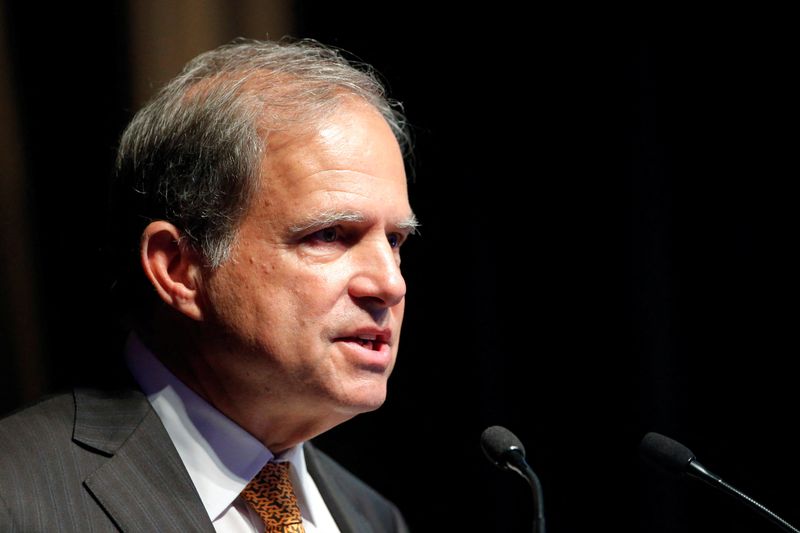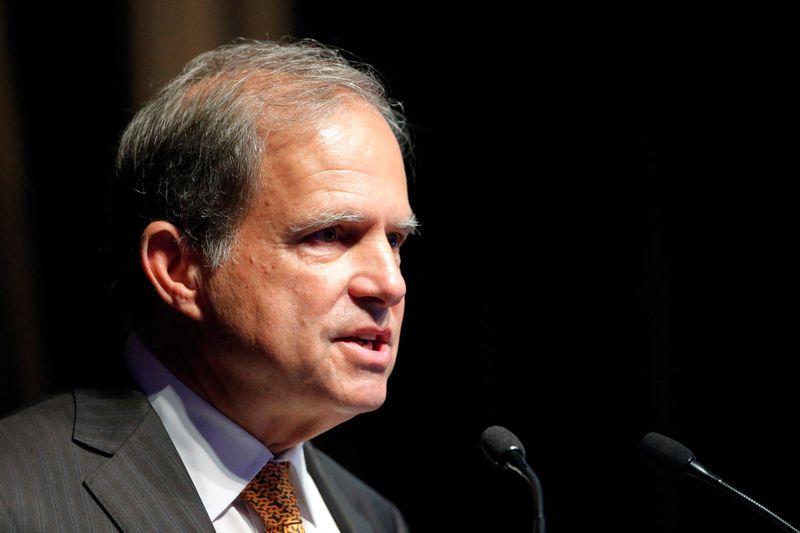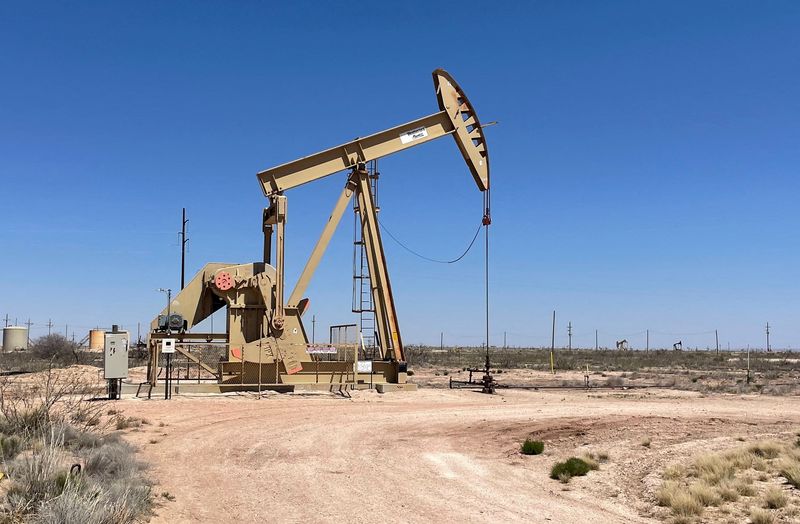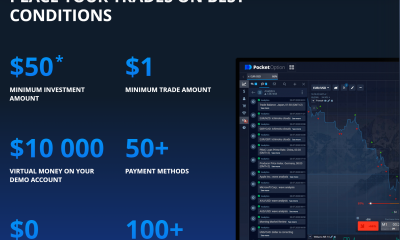Commodities
As oil majors cast shale nets, Texas oilman Sheffield made Pioneer the prized catch


© Reuters. FILE PHOTO: Scott Sheffield, Chairman and Chief Executive Officer of Pioneer Natural Resources Company, speaks to guests and investors during the OGIS conference for mid- and small-tier oil and gas companies in New York, April 8, 2014. REUTERS/Eduardo Mu
2/2
By Arathy Somasekhar
HOUSTON (Reuters) – Four years ago, Texas oilman Scott Sheffield saw the oil majors were moving aggressively into the top U.S. shale basin and plotted to make his then-$24 billion Pioneer Natural Resources (NYSE:) the oilfield’s biggest prize.
The CEO concentrated the business, exiting less productive properties and dumping an in-house service arm, and set out a mission to make Pioneer the leanest, profitable and most desirable catch among U.S. shale independents.
Sheffield emerged as a shale statesman, encouraging the U.S. to lift a 40-year ban on exports of oil and snatching up rivals while publicly warning of a coming consolidation.
On Oct. 11, the 71-year-old’s mission paid off as oil giant Exxon Mobil (NYSE:) offered $59.5 billion for the oil and gas firm – more than twice its value in 2019.
“Pioneer sat in a position of being a predator and prey, said Dan Pickering, a long-time shale investor and head of investment firm Pickering Energy Partners. “He was thinking multiple steps ahead.”
TEHRAN HIGH SCHOOL
Oil runs in the family’s blood. Sheffield’s father was an Atlantic Richfield Co executive who brought his family to Iran where Sheffield spent his high school years. He developed a fierce desire to win as quarterback on his Tehran school’s American football team, said son Bryan Sheffield.
“Scott is a huge competitor. That’s what drives him. It’s about being competitive with his peer group,” said the younger Sheffield, one of five siblings and co-managing partner at investment firm Formentera Partners.
After college, Sheffield worked for Amoco Corp and later joined his father-in-law’s oil company and became CEO five years later. That company would become Pioneer Natural Resources.
It grew from a small, $30 million family business in West Texas to one of the largest after combining with corporate raider Boone Pickens’ Mesa Energy in 1997 and later discovering the shale oil hidden below its acreage.
Sheffield retired two decades later but returned as CEO in 2019 after the company overspent and overpromised investors.
On his return, he made Permian oil its sole focus: putting processing, oilfield services and South Texas shale assets on the block. Those generated about $1 billion in cash to buy rivals.
He also embraced an emerging philosophy that emphasized shareholder returns over rapid production gains, rejecting a plan to more than quadruple Pioneer’s oil production by 2026.
“The big change is to treat capital just as important as production,” he told investors in his first earnings report as resuming control of the company.
Sheffield was unavailable to comment for this article.
READING TEA LEAVES
Daniel Yergin, an economic historian and author of “The New Map,” on the influence of U.S. shale on global markets, said Sheffield was a prescient reader of industry trends.
“He picks up signals,” said Yergin.
Two of Sheffield’s most significant insights were the major role technology would play in reshaping U.S. oil production and the recognition that big oil companies would eventually control the Permian, he said.
In comments after the deal was disclosed, Sheffield and Exxon CEO Darren Woods said they agreed to terms of a sale two weeks after the pair first sat down to negotiate.
Sheffield long espoused Pioneer and other shale firms needed “size and scale” to survive the next downturn as many oil companies have been wiped out over the years by OPEC price wars.
He made the company more attractive by bulking up with purchases of DoublePoint Energy and his son’s Parsley Energy (NYSE:) for $11 billion combined as the COVID-19 oil crash slashed stock prices.
The strategy of restraining production to boost shareholder returns has not sat well with those who believe it has diminished the U.S. role in oil markets.
“I have been frustrated at the extent to which he’s tried to suggest the U.S. oil and gas sector needed to embrace his unique brand of discipline across the board,” said Doug Sheridan, managing director of research firm EnergyPoint Research.
SALE WINNERS
Sheffield is one of the deal’s biggest winners. He will receive a $29 million severance package, about $100 million in Exxon shares, and get a seat on Exxon’s board after the sale concludes next year.
His bluntness and reputation for a photographic memory may clash with Exxon’s insular culture.
“He’s willing to stand up and say what he believes and willing to go talk to anyone on the global stage,” said Bruce Vincent, former president of Swift Energy, who has known Sheffield for more than 30 years.
Pioneer employees occasionally were hesitant to give him projections knowing Sheffield would remember them and question them later if the outcome did not match, said a former employee.
He will have to rein in his outspokenness to remain on Exxon’s tight-lipped board, said son Bryan.
“I don’t think he can be outspoken. That would be a no-no as a board member,” he said.
Commodities
Oil prices rise; U.S. crude inventories plunge, Russia-Ukraine truce eyed
Commodities
India’s Reliance to stop buying Venezuelan oil over US tariffs, sources say
Commodities
Oil prices climb on Venezuela supply worries

 Forex3 years ago
Forex3 years agoForex Today: the dollar is gaining strength amid gloomy sentiment at the start of the Fed’s week

 Forex3 years ago
Forex3 years agoUnbiased review of Pocket Option broker

 Forex3 years ago
Forex3 years agoDollar to pound sterling exchange rate today: Pound plummeted to its lowest since 1985

 Forex3 years ago
Forex3 years agoHow is the Australian dollar doing today?

 Cryptocurrency3 years ago
Cryptocurrency3 years agoWhat happened in the crypto market – current events today

 World3 years ago
World3 years agoWhy are modern video games an art form?

 Commodities3 years ago
Commodities3 years agoCopper continues to fall in price on expectations of lower demand in China

 Economy3 years ago
Economy3 years agoCrude oil tankers double in price due to EU anti-Russian sanctions























